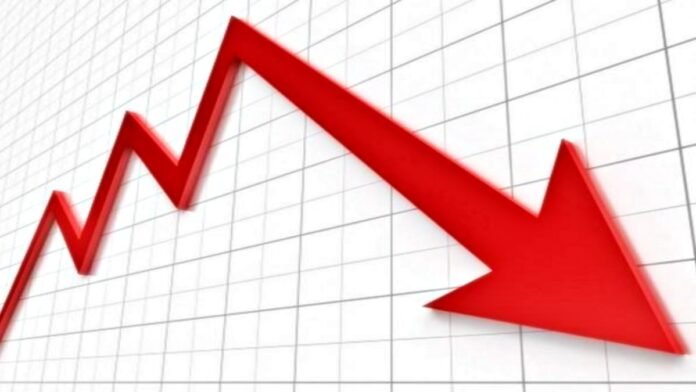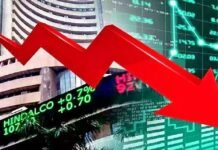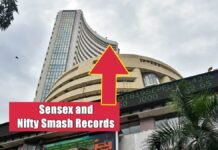
Key Points:
- The BSE Sensex plunged 1,414 points (1.9%) to close at 73,192, while the Nifty50 dropped 418 points (1.9%) to settle at 22,126 on February 28.
- This marks the fifth consecutive monthly decline for the indices, the longest losing streak in 29 years.
- Market capitalization of BSE-listed companies fell by ₹8.9 lakh crore to ₹384.22 lakh crore in a single day.
- Factors driving the sell-off include weak global cues, concerns over U.S. tariffs, slowing economic growth, MSCI rebalancing, and persistent foreign investor outflows.
New Delhi: Indian equity markets witnessed a bloodbath on Friday, February 28, as benchmark indices BSE Sensex and Nifty50 tumbled nearly 2% amid a confluence of global and domestic challenges. The Sensex nosedived 1,414 points to close at 73,192, while the Nifty50 fell 418 points, ending below the critical 22,150 mark at 22,126.
This steep decline capped off a dismal February for Indian markets, marking the fifth straight month of losses, the longest such streak since 1996. Broader markets also suffered heavy losses, with the BSE MidCap and SmallCap indices falling over 2.2% each.
Key Drivers Behind the Market Crash
- Global Trade Tensions:
U.S. President Donald Trump’s announcement of additional tariffs on Mexican and Chinese goods rattled global markets. The tariffs are set to take effect on March 4, adding to fears of a full-scale trade war. - Foreign Investor Outflows:
Foreign Institutional Investors (FIIs) continued their relentless selling spree, offloading a net $12.2 billion worth of Indian equities in 2025 so far. FIIs are reallocating capital to China and Europe due to better growth prospects. - Weak Earnings Momentum:
Disappointing Q3 earnings from Indian banks and IT companies have weighed heavily on investor sentiment. Analysts predict further weakness in Q4 results. - MSCI Rebalancing:
The anticipated rebalancing by global index provider MSCI has triggered portfolio adjustments by both domestic and foreign investors, adding to market volatility. - Concerns Over GDP Data:
Investors are bracing for India’s Q3 GDP data release later today amid fears of slowing economic growth.
Sectoral Carnage: IT and Banking Hit Hard
All major sectoral indices ended deep in the red:
- The Nifty IT index plunged nearly 4%, mirroring overnight losses in U.S. tech stocks like Nvidia.
- Banking stocks also faced significant pressure due to weak earnings forecasts; the Bank Nifty fell by over 0.6%.
- Auto, metal, pharma, and consumer durables sectors recorded declines between 1% and 2%.
Top losers included IndusInd Bank (-6.18%), Tata Steel (-3.02%), M&M (-4.14%), Infosys (-3%), and HCLTech (-3%).
Market Breadth Paints a Grim Picture
The market breadth was overwhelmingly negative:
- On the NSE, only 400 stocks advanced, while a staggering 2,221 stocks declined.
- On the BSE, just 606 shares gained, compared to 2,253 losers.
This widespread sell-off resulted in a massive erosion of wealth for investors as the total market capitalization of BSE-listed companies fell by ₹8.9 lakh crore to ₹384.22 lakh crore.
Historical Perspective: Longest Losing Streak Since 1996
The ongoing downturn has pushed Indian markets into their longest losing streak in nearly three decades:
- Since peaking in September 2024, benchmarks have declined over 15%, eroding ₹85 lakh crore in investor wealth.
- Comparatively milder than past bear phases like the 1996 crash (26% decline), this streak reflects persistent global uncertainty and domestic challenges.
Expert Commentary: What Lies Ahead?
Market experts remain cautious about near-term prospects:
- V.K. Vijayakumar from Geojit Financial Services remarked: “Markets dislike uncertainty, and Trump’s unpredictable tariff policies have added fuel to an already volatile environment.”
- Osho Krishnan from Angel One highlighted that Nifty’s support level at 22,400 will be critical for determining whether further declines are imminent or if a rebound is possible.
Government Response and Investor Outlook
The government is closely monitoring market developments as concerns over slowing economic growth mount ahead of GDP data release later today. Analysts expect GDP growth for Q3 FY25 to remain subdued but are hopeful for a rebound in subsequent quarters due to improving fiscal policies and infrastructure spending.
Meanwhile, retail investors are advised to adopt a cautious approach:
- Focus on fundamentally strong large-cap stocks.
- Avoid speculative bets amid heightened volatility.
- Monitor global developments closely as they continue to influence domestic markets.
A Challenging Road Ahead
The Indian stock market’s sharp decline on February 28 underscores the fragility of global financial systems amid geopolitical tensions and economic uncertainties. With benchmarks down nearly 15% from their September highs and broader indices deep in bear territory, investors face a challenging road ahead.
As markets navigate this turbulent phase, all eyes will be on key economic indicators like GDP data and corporate earnings for signs of recovery or further pain ahead. For now, caution remains the watchword for market participants navigating this stormy period on Dalal Street.
















































